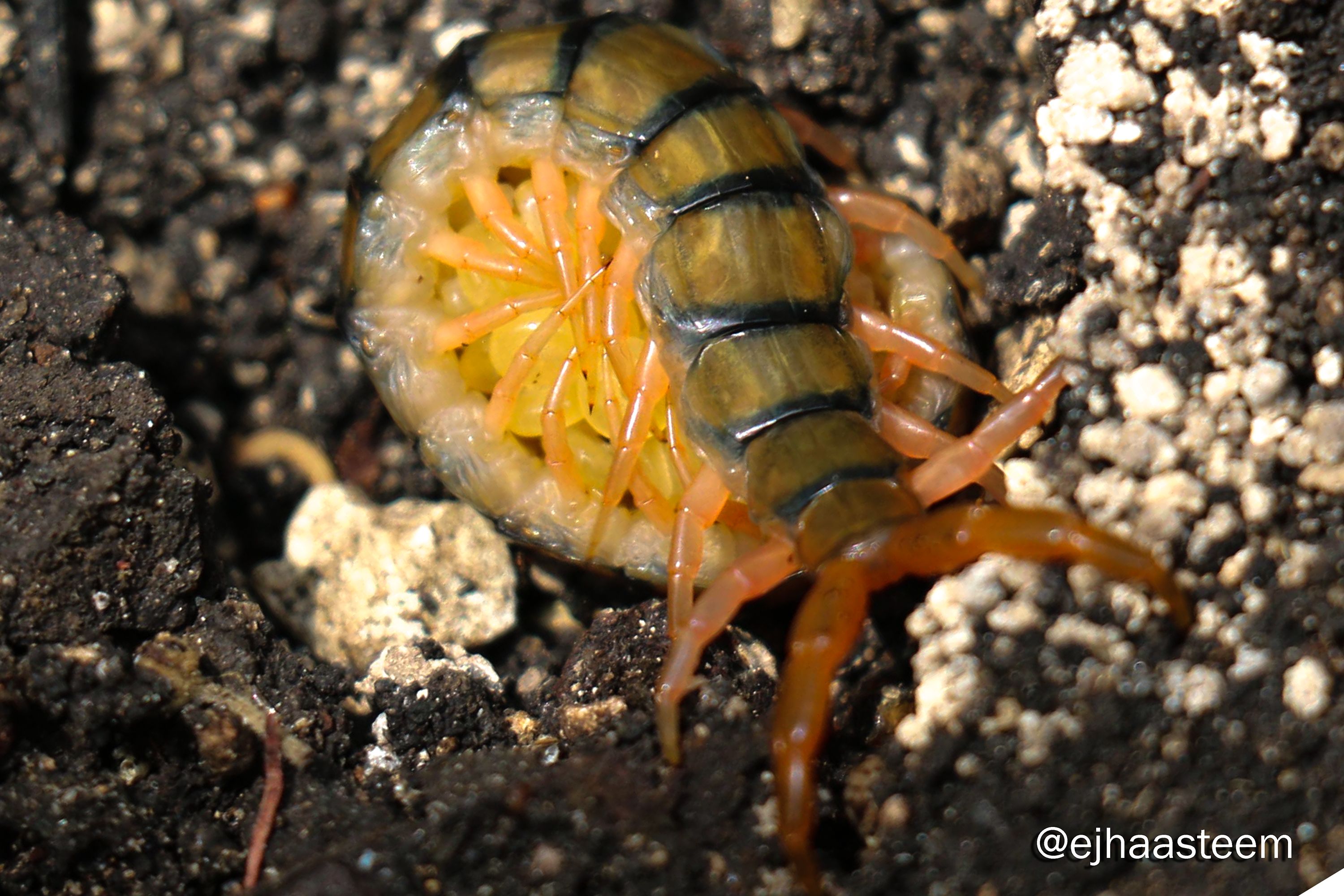Recognize The Centipede With a Scientific View
Hi Steemian ,,,, this is a centipede that I took 3 years ago in a forest in Aceh, as I immortalize the centipede image, he incubated his egg, under a boulder.
It took a lot of effort to take this picture, especially my fear of seeing him so ferocious. This picture I've ever posted before, but it contains only a few pictures, without a scientific description of this image.
Today I am posting this image, with some detailed description of this centipede, from some sources I was looking for, the goal is for the development of science.
Hopefully my post is useful.

Centipedes belong to class of Chilopoda. The name centipede, which means “100 legs,” can be somewhat misleading: centipedes may have anywhere from 15 to 177 pairs of legs. Centipedes are elongated, with flat, segmented bodies that contain a pair of legs per segment. Centipedes occur in several colors and patterns but most common are brown and reddish orange. They range in size from 4 to 152 mm, depending on the species.
The heads of centipedes have a pair of long and sensitive antennae. They have small mouths and have large, clawlike structures that contain a venom gland. Because most centipedes are carnivorous creatures that forage for food at night, they use their claws to paralyze their victims, such as worms, spiders and small vertebrates.

Behavior, Diet & Habits
Adult centipedes hide in moist, dark and secluded areas during winter. They place eggs in dampened soil during summer or spring. As centipedes become adults, they grow a complete set of legs and extra segments. Most centipedes live for more than a year and some up to six years. Centipedes may enter houses and buildings, but they do not roam during daytime. They hide in damp areas around bathrooms, closets, basements and other sites typically infested by pests.
Centipedes detect prey through the use of their antennae, which are covered with dense hairs. Their prey is immobilized by venom injected from the maxilliped fang and held in place by the maxillipeds. Prey is passed to the mouth via the first and second maxillae and is then broken down by the mandibles. Most centipedes are carnivorous and prey upon soft-bodied insects, spiders, worms and other arthropods, including other centipedes.
Centipedes are not likely to consume wood. In actuality, arthropods commonly known as wood eating centipedes are millipedes. While millipedes do closely resemble centipedes, millipedes are herbivores and detritivores, subsisting on dead and decaying plant material, including wood or cellulose material.
More Information
Centipedes are fast moving, agile, nocturnal animals. They are rarely seen by humans due to their nocturnal activity and the speed with which they move. While some centipedes have compound eyes containing as many as 200 optical units, others do not have eyes. All centipedes have very poor eyesight and track their prey through the use of touch and smell. Provided that they are able to escape from predators and that their surroundings are conducive to survival, centipedes can live as long as six years. Among arthropods, this lifespan is considered longer than many. Centipedes are venomous. Their venom allows them to attack prey and defend themselves against predators and other natural enemies. Centipede venom is not normally life endangering to humans, although the bite can be painful.
Centipedes in North America
Centipedes are found in a variety of North American environments, from harsh deserts to moist, deciduous forests. Centipedes in the United States are some of the largest of their kind. The sizeable North American centipede (Scolopendra hero) and the Sonoran Desert centipede, can be found in arid wastelands. These centipedes are found within the United States and Northern Mexico, where they thrive under rocks and logs. Indoors, the most likely encountered centipede species is the house centipede (Scutigera coleoptrata). It ranges from 25 to 38 mm and possesses extremely long legs. They have the ability to travel along walls as well as floors.
Centipede Control Methods
Because centipedes feed on insects and other arthropods, eliminating their food sources is a step toward controlling centipedes. For this reason, it’s ideal to identify all other pests inside houses and buildings before performing any pest control. Although centipedes may help homeowners get rid of insects like cockroaches and houseflies, large species could produce bites that are as painful as bee stings. Some centipedes can run quickly when disturbed. When they are handled, centipedes may bite, causing severe pain, numbness, discoloration and inflammation. For common house centipedes, setting sticky traps can be a way to accurately gauge centipede population levels. This activity will also help to identify potential routes of access within your home. If an infestation is confirmed, homeowners should try to reduce moisture and seal entry routes to the house or dwelling. Moisture in a building’s foundation can be a problem and lead to an infestation, as can water accumulated from the roof. Keep leaves, wood, compost and other organic material away from the sides of the home or building. Consult your local pest control professional.
How Orkin treats for centipedes
Centipedes are a diverse group of Arthropods with a range of behavioral characteristics. Therefore, when centipedes become a problem, the first thing to do is contact your pest management professional and request an inspection. Once the inspection is complete, your pest management professional will prepare a centipede treatment plan designed to control the centipede species causing problems. Centipede treatment usually involves both non-chemical and chemical control methods, but the treatment plan will emphasize finding where centipedes are located and how they are getting inside the home.
Some non-chemical treatments that may be included in the treatment plan include:
- Reducing moisture problems by repairing water leaks or using dehumidifiers
- Reducing clutter that provides centipedes with protection and a place to hide. Your pest management professional will likely point out these places and recommend not allowing stored items to be stacked right up against the wall or rest directly on the floor.
- Reducing the number of insects and spiders that provide a food source for centipedes
- Sealing holes, cracks and gaps that enable outdoor centipedes, insects and spiders to get inside a home
- Removing indoor centipedes with a vacuum
Generally, chemical control methods are used for temporary centipede control. If needed, your pest management professional will use insecticides in cracks, crevices and other centipede harborage areas. If the centipede population is especially heavy outdoors, the plan may include chemical applications to the cracks or gaps in the foundation, in the crawl space or the mulch around the house.
Centipede Eggs

Centipedes may be a occasional household sight, but their eggs can be difficult to find. Most centipede eggs are deposited in soil. In temperate areas, centipede egg-laying occurs in spring and summer. In subtropical and tropical areas, centipedes may lay their eggs at any time.
Centipedes are solitary in nature and most species mate without direct contact. Males will spin small webs into which they deposit sperm. Females find these webs, take them in and fertilize the ova within their own bodies. However, some species do have courtship rituals.
Egg-laying locations and habits vary by species. Females of some species coil around their eggs to guard them from predators and lick them to remove mold spores. Despite the care these species take, females sometimes abandon their eggs after a disturbance. At this time, fungi begin to grow and consume them.
Most species of centipedes lay eggs that hatch into miniature versions of the adults. Once hatched, most centipedes carry only a fraction of their sets of legs. They gain the rest of their legs through a series of molts.
Centipedes’ Reproductive Cycle
Centipedes do not undergo a process of metamorphosis, though their young may pass through several molts during growth. Centipedes mate in warm months and stay dormant through winter. A centipede may live up to six years.
The centipede reproductive cycle involves distinct rituals. The female centipede first releases pheromones to attract a male, who, in some species, then weaves a silk pad deposited with sperm, known as a spermatophore. The spermatophore is either left for her to find and take up or is brought to her attention via a courtship dance, during which the male taps the female’s posterior legs with his antennae. Typical indoor centipede’s reproductive cycle produces up to 35 eggs. Other species of centipedes give birth to living young.
Centipedes lay their eggs in the hollows of rotting logs or in the soil. Most females will tend to their eggs and hatchlings, curling their bodies around their brood for protection. In addition, eggs are prone to the growth of fungi and require grooming to ensure that they reach adulthood. However, some species may abandon or eat their eggs.
Upon hatching, many centipede young have fewer pairs of legs than the adults and acquire the additional body segments and legs each time they molt. Because centipedes have outer skeletons, they must undergo a series of molts, shedding their exteriors. However, the hatchlings of the Scolopendromorphae and Geophilomorphae are born with a complete set of legs.
Sources article :
https://www.orkin.com/other/centipedes/centipede-eggs/
https://www.orkin.com/other/centipedes/
https://www.orkin.com/other/centipedes/centipedes-reproductive-cycles/
Follow Me : @ejhaasteem



Nice photo! But i dont like centipedes, i remember in my childhood days when that centipede bit me on my toe i got sick in bed for two days.